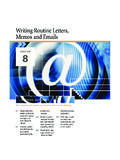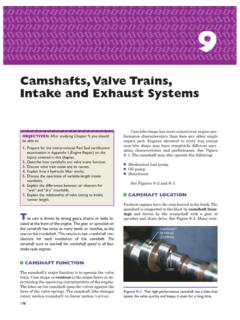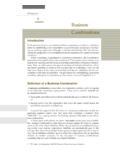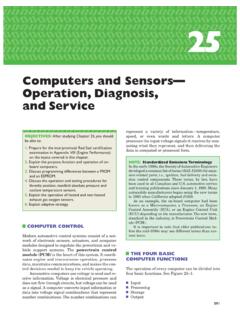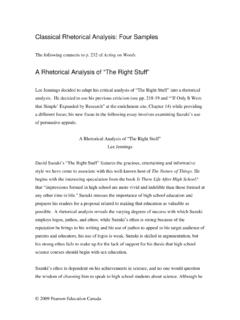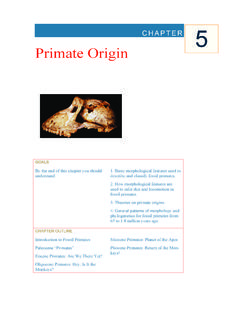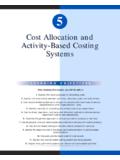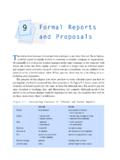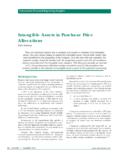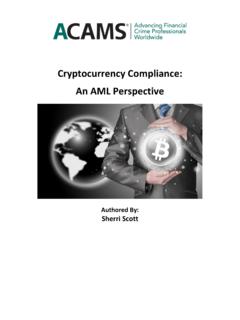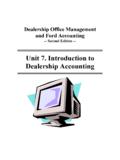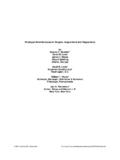Transcription of Revenue and Expense Recognition - Pearson
1 Rene Johnston/ CHAPTER BMW Group (Bayerische Motoren Werke or Bavarian Motor Works, com, Frankfurt Stock Exchange ticker: BMW) is one of the world s leading luxury vehicle manufac-turers. The company s portfolio includes well-recognized brands such as MINI, Rolls-Royce, and, of course, BMW. You should already be familiar with the accounting for the Revenue and cost of sales for tangible products such as cars: roughly speaking, Revenue and costs are recorded at the point of sale. However, BMW also sells some of its vehicles to car rental companies. In some cases, BMW has an obligation to take back the vehicles after a period of time. When should the company recognize revenues for such transactions? Is the appropriate time at the point of sale? BMW often includes a package of services in conjunction with the sale of each vehicle. For example, if the sale of a BMW 323i sedan for $35,000 includes four years of maintenance services such as oil changes and tune-ups, should the company record the full $35,000 as Revenue at the point of sale?
2 In addition to manufacturing and selling cars and motorcycles, BMW also provides fi nancial services in the form of vehicle loans and leases. How should BMW recognize Revenue from these fi nancial services? Revenue and Expense Recognition After studying this chapter, you should be able to: 4-1. Explain why there is a range of alternatives for rev-enue Recognition that are concep-tually valid and the rationale for accounting standards to prescribe a smaller set of alternatives. 4-2. Apply the general Revenue and Expense Recognition criteria to a variety of contexts involving the sale of goods and provision of services. 4-3. Apply the specifi c Revenue and Expense Recognition criteria for construction contracts, including the prospective treat-ment applicable to changes in estimates. 4-4. Apply the principle of conservatism to the accounting for construction contracts. 4-5. Evaluate the risks of Revenue misstatements and the appropriateness of Revenue Recognition policies in specifi c circumstances by applying professional judgment.
3 LEARNING OBJECTIVES 4 10911/27/10 9:25 AM11/27/10 9:25 AM CONTENTS A. RANGE OF CONCEPTUAL ALTERNATIVES FOR Revenue Recognition 110 B. GENERAL Revenue Recognition CRITERIA 112 1. Sale of goods 112 2. Provision of services 113 C. Expense Recognition 115 D. SPECIFIC Revenue Recognition SITUATIONS 115 1. Consignment sales 116 2. Installment sales 116 3. Franchise Revenue 117 4. Barter transactions 118 5. Revenue Recognition at point of production 118 E. ACCOUNTING FOR CONSTRUCTION CONTRACTS 119 1. Revenue Recognition for cost-plus contracts 120 2. Revenue Recognition for fi xed-price contracts: Application of changes in estimates 121 3. Revenue Recognition for fi xed-price contracts: The cost-to-cost approach 123 4. Accounting cycle for construction contracts 124 5. Application of prudence (conservatism) in accounting for construction contracts 127 6. Revenue Recognition when outcome of construction contracts is uncertain: cost recovery method 129 7.
4 Alternative in ASPE: Completed contract method 130 F. RISK OF EARNINGS OVERSTATEMENT IN CONSTRUCTION CONTRACTS 130 1. Intentional overstatement: Earnings management 131 2. Unintentional overstatement: The winner s curse 132 G. PRESENTATION AND DISCLOSURE 133 1. General presentation and disclosure requirements 133 2. Presentation and disclosure for construction contracts 133 H. SUBSTANTIVE DIFFERENCES BETWEEN IFRS AND ASPE 134 I. SUMMARY 134 J. REFERENCES 135 K. GLOSSARY 136 L. PROBLEMS 136 M. MINI-CASES 149 Recognition is the process of presenting an item in the fi nancial statements, as opposed to merely disclosing that item in the notes. Many transactions and items that meet the defi nitions of fi nancial statement elements (asset, liability, equity, Revenue , ordinary Expense , gain, loss; see Chapter 2) do not appear on the bal-ance sheet or income statement. For example, some patents will meet the defi ni-tion of an asset, but the value of patents usually is not recognized on the balance sheet.
5 In this chapter, we focus on the Recognition of revenues and expenses on the income statement. A. RANGE OF CONCEPTUAL ALTERNATIVES FOR Revenue Recognition In theory, there is a wide range of possible points at which Revenue could be rec-ognized. The breadth of this range refl ects a business s value creation process, as illustrated in Exhibit 4-1. (For simplicity, the diagram is linear even though the different stages can sometimes overlap with each other.) In terms of value creation, the earliest point at which one can reasonably argue for Revenue Recognition is Recognition The process of presenting an item in the fi nancial statements, as opposed to merely disclosing that item in the notes. 4-1. Explain why there is a range of alternatives for rev-enue Recognition that are concep-tually valid and the rationale for accounting standards to prescribe a smaller set of alternatives. 11011/27/10 9:25 AM11/27/10 9:25 AMA. Range of Conceptual Alternatives for Revenue Recognition 111when the knowledge for a business, product, or process is developed for exam-ple, a biotechnology company creates value for its owners when it discovers a new vaccine for a disease, or a mining company when it discovers a rich deposit of aluminum.
6 For a publicly traded company, the value created will often be evident in the stock price of the enterprise, if the discoveries are signifi cant in relation-ship to the size of that enterprise. Conceptually, it is possible to argue for Revenue Recognition at this point because the company will be able to monetize these dis-coveries at some point in the future, either by commercializing the breakthroughs or selling the knowledge to another party. The value creation process continues with marketing efforts and the receipt of orders from customers. The production process, of course, also adds value. Depending on whether the product is a good or service, delivery occurs during production (for a service) or after production (for a good). If the business makes the sale on credit, then a portion of value added is in the form of fi nancial services ( , lending to the buyer). Furthermore, many businesses provide a guarantee against product defects or provide warranties that their products will be in good operating condition for a certain length of time.
7 These guarantees are also part of the value-added services provided by the business since they encourage more customers to buy from the enterprise. At the most conservative extreme, a busi-ness would delay Revenue Recognition to the point at which the warranty period has elapsed and it has received all payments from the customer. This is illustrated on the far right in Exhibit 4-1. Exhibit 4-1 A business s value creation process If the full range of alternatives discussed above and portrayed in Exhibit 4-1 were acceptable accounting policies, the potential disparities among the fi nancial statements of different companies would be immense. This great scope of choice obviously impairs the comparability of fi nancial statements among enterprises. More importantly, the methods that recognize Revenue early in the value cre-ation process entail substantially more uncertainties about the cash fl ows that the enterprise will ultimately realize, and correspondingly lower degrees of verifi ability and reliability.
8 As we discussed in Chapter 1, less reliable account-ing numbers are less useful for contracting purposes, particularly for evaluating the performance of management. Less reliable performance measures allow a greater degree of moral hazard: the easier it is for management to manipulate the reported performance, the more diffi cult it is to motivate desirable value creation activities. For example, if a biotechnology company were to be able to recog-nize Revenue when it discovers a new vaccine, determining the amount of rev-enue would require estimates of the likelihood of the drug passing all regulatory Invent goodor service,discoverresourceReceiveorderFini shproductionTime of sale ordeliveryCompletecashcollectionExpiry ofwarrantyProductionCollectionperiodWarr antyperiodTimeNote: Depending on the specific type of business, the ordering of activities in thevalue creation process may differ from that illustrated. 12 11111/27/10 9:25 AM11/27/10 9:25 AM112 CHAPTER 4 Revenue and Expense Recognitionapprovals and, subsequent to that, future price and demand for the vaccine.
9 In turn, future price and demand forecasts depend on the availability of similar or alternative treatments, the potential development of other new and superior vac-cines in the future, whether government or private health insurance providers will cover the cost of the vaccine and the amount they would be willing to pay, and so on. As you can see, this would be a daunting forecasting exercise. Not only would the forecast results lack precision, they would be virtually impossible for an auditor to verify. Given the lack of verifi ability, management will have signifi cant latitude to bias the forecasts to its advantage, so this information has questionable value as a refl ection of management performance. In summary, early Revenue Recognition methods entail more uncertainty, requiring more estimates and judgments from management, resulting in fi nan-cial statements that are less accurate gauges of managerial performance.
10 Con-sequently, accounting standards specify Revenue Recognition criteria that allow only a subset of Revenue Recognition policies depicted in Exhibit 4-1. The next section discusses these criteria. B. GENERAL Revenue Recognition CRITERIA IFRS specifi es Revenue Recognition criteria in IAS 18. The criteria differ depending whether the Revenue relates to the sale of goods or the provision of services. The two sets of criteria arise due to the fact that goods and services differ fundamentally from each other in many key aspects. Let us fi rst examine the sale of goods. 1. Sale of goods Paragraph 14 of IAS 18 provides the following Revenue Recognition criteria for the sale of goods. 14. Revenue from the sale of goods shall be recognized when all the following conditions have been satisfi ed: (a) the entity has transferred to the buyer the signifi cant risks and rewards of ownership of the goods; (b) the entity retains neither continuing managerial involvement to the degree usually associated with ownership nor effective con-trol over the goods sold; (c) the amount of Revenue can be measured reliably; (d) it is probable that the economic benefi ts associated with the transaction will fl ow to the entity; and (e) the costs incurred or to be incurred in respect of the transaction can be measured reliably.
